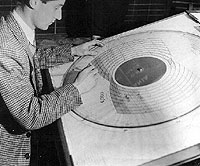
During
the War, the widespread installation of radio facilities made it possible to take
positive control of flights en route. Aircraft were separated by the most rudimentary
rules: northbound aircraft flew at odd thousands of feet and those southbound
at even thousands. Also, aircraft flying at the same height along an air route
had to be separated by ten minutes flying time. With aircraft of vastly different
speeds on the same trunk air routes, a procedure was needed to maintain this longitudinal
separation.
The problem was for the Flight Checking Officer (FCO - as Air Traffic Controllers were then known) to quickly determine when a faster aircraft would draw closer than 10 minutes to the aircraft in front, or when aircraft flying in opposite directions would pass.
The
solution was presented in 1944 by a Sydney Flight Checking Officer, Mr Norman
Rodoni, who invented a form of computer known as the Airways Traffic Computer
or 'Rodoniscope'.
Aircraft were plotted on the glass disk in grease pencil.
The FCO could rotate the plot to any point along the aircraft's route to check
the estimated times of arrival at any reporting point. He could also compare one
aircraft's position relative to another aircraft on the same route, either in
the same or opposite direction.
Fast aircraft appeared on the outside of the disk, slower ones toward the centre. Thus it was possible to tell when a fast aircraft would overtake a slower one.
The limitation of this system was the speed and accuracy of plotting aircraft position reports, which were relayed to the FCO by Aeradio.
Mr Rodoni's simple invention halved the number of controllers needed, and was more accurate than other, more cumbersome, methods of control. Despite its officially agreed merits, it was not until 1950 that he was finally paid £200 by the Public Service Board and a further £250 by the War Inventions Committee.
(Photo: CAHS collection)

.jpg)